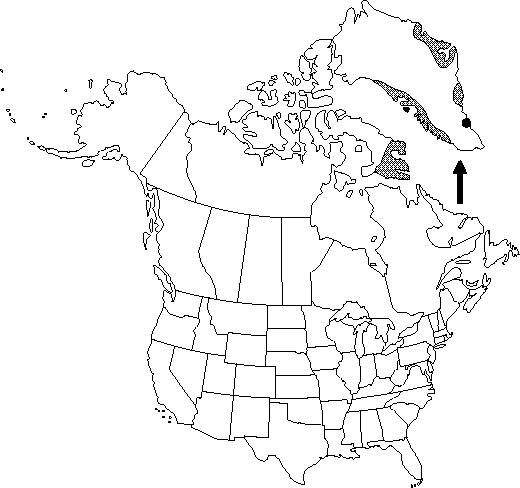Difference between revisions of "Betula nana subsp. nana"
FNA>Volume Importer |
FNA>Volume Importer |
||
| Line 13: | Line 13: | ||
}}<!-- | }}<!-- | ||
| − | --><span class="statement" id="st- | + | --><span class="statement" id="st-undefined" data-properties=""><b>Shrubs,</b> procumbent, widely spreading, or upright, to 1 m. <b>Bark</b> dark brown. <b>Twigs</b> sparsely to densely pubescent, dull, without heavy resinous coating, without large, warty, resinous glands. <b>Leaf</b> blade broadly orbiculate or obovate-orbiculate to reniform, 0.8–1.5 × 0.8–2 cm, base rounded or cuneate to nearly cordate; surfaces abaxially sparsely pubescent to glabrous. <b>Infructescences</b> 0.5–1.5 × 0.4–1 cm; scales glabrous, lobes diverging distal to middle, ascending, about equal in length. <b>2n</b> = 28.</span><!-- |
-->{{Treatment/Body | -->{{Treatment/Body | ||
| Line 19: | Line 19: | ||
|habitat=Tundra, open rocky barrens, and scrubs, in Europe subalpine mountain moors | |habitat=Tundra, open rocky barrens, and scrubs, in Europe subalpine mountain moors | ||
|elevation=0–600 m | |elevation=0–600 m | ||
| − | |distribution=Greenland;N.W.T.;n Europe | + | |distribution=Greenland;N.W.T.;n Europe. |
|discussion=<p>Betula nana subsp. nana occurs in both eastern and western Greenland at latitudes north of 63 degrees. In Europe, the range of this subspecies extends across the subarctic zone and southward in the Alps and other ranges.</p> | |discussion=<p>Betula nana subsp. nana occurs in both eastern and western Greenland at latitudes north of 63 degrees. In Europe, the range of this subspecies extends across the subarctic zone and southward in the Alps and other ranges.</p> | ||
|tables= | |tables= | ||
| Line 39: | Line 39: | ||
|habitat=Tundra, open rocky barrens, and scrubs, in Europe subalpine mountain moors | |habitat=Tundra, open rocky barrens, and scrubs, in Europe subalpine mountain moors | ||
|elevation=0–600 m | |elevation=0–600 m | ||
| − | |distribution=Greenland;N.W.T.;n Europe | + | |distribution=Greenland;N.W.T.;n Europe. |
|reference=None | |reference=None | ||
|publication title= | |publication title= | ||
|publication year= | |publication year= | ||
|special status= | |special status= | ||
| − | |source xml=https://jpend@bitbucket.org/aafc-mbb/fna- | + | |source xml=https://jpend@bitbucket.org/aafc-mbb/fna-data-curation.git/src/9216fc802291cd3df363fd52122300479582ede7/coarse_grained_fna_xml/V3/V3_763.xml |
|subfamily=Betulaceae subfam. Betuloideae | |subfamily=Betulaceae subfam. Betuloideae | ||
|genus=Betula | |genus=Betula | ||
|species=Betula nana | |species=Betula nana | ||
|subspecies=Betula nana subsp. nana | |subspecies=Betula nana subsp. nana | ||
| − | |||
| − | |||
| − | |||
| − | |||
| − | |||
| − | |||
| − | |||
| − | |||
| − | |||
| − | |||
| − | |||
| − | |||
| − | |||
| − | |||
| − | |||
| − | |||
| − | |||
| − | |||
| − | |||
| − | |||
| − | |||
| − | |||
}}<!-- | }}<!-- | ||
-->[[Category:Treatment]][[Category:Betula nana]] | -->[[Category:Treatment]][[Category:Betula nana]] | ||
Revision as of 14:49, 27 July 2019
Shrubs, procumbent, widely spreading, or upright, to 1 m. Bark dark brown. Twigs sparsely to densely pubescent, dull, without heavy resinous coating, without large, warty, resinous glands. Leaf blade broadly orbiculate or obovate-orbiculate to reniform, 0.8–1.5 × 0.8–2 cm, base rounded or cuneate to nearly cordate; surfaces abaxially sparsely pubescent to glabrous. Infructescences 0.5–1.5 × 0.4–1 cm; scales glabrous, lobes diverging distal to middle, ascending, about equal in length. 2n = 28.
Phenology: Flowering late spring.
Habitat: Tundra, open rocky barrens, and scrubs, in Europe subalpine mountain moors
Elevation: 0–600 m
Distribution

Greenland, N.W.T., n Europe.
Discussion
Betula nana subsp. nana occurs in both eastern and western Greenland at latitudes north of 63 degrees. In Europe, the range of this subspecies extends across the subarctic zone and southward in the Alps and other ranges.
Selected References
None.